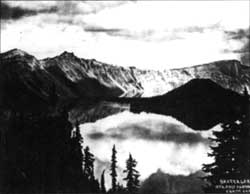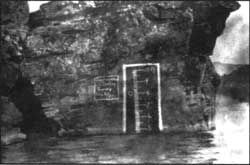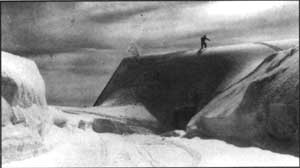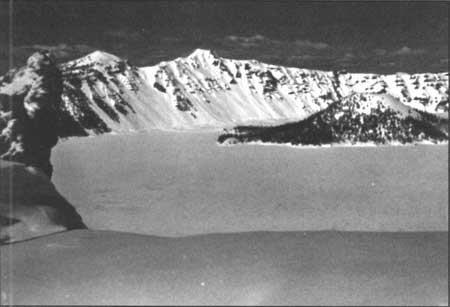Not So Static a Scene
The famous pioneer artist and photographer Peter Britt first captured the unusual beauty of Crater Lake on a glass plate negative in 1874. Even in black and white, the magnificence of the scenery was clearly visible. Some 126 years later you can walk to the spot where Britt took his photographs and discover that the view of the lake has not noticeably changed. One might ask how it is possible that this deepest lake in the United States, the result of one of the largest volcanic eruptions in North America, has found some special state of tranquility?
 Peter Britt took this photo of Crater Lake in 1874. Southern Oregon Historical Society photo, Medford. |
Crater Lake’s physical setting is certainly unusual. The lake sits within a basin called a caldera, created when Mount Mazama exploded and collapsed here some 7,700 years ago. Within a few centuries, a lake appeared with a depth of nearly 2,000 feet. At the present time, the total volume of water located beneath its surface comes close to 4.5 trillion gallons. That is enough lake water to provide 750 gallons to each man, woman, and child on earth. Since the lake occupies a caldera, the surface area is restricted to about 21 square miles, with the widest point being a little more than 6 miles. Towering rocky walls loom above the entire shoreline with some rising to nearly 2,000 feet, These slopes stop the flow of streams originating from outside the caldera.
Given the physical restrictions nature has imposed upon this lake, how is it that this apparently stagnant pool of water can remain so blue and clear for so long? What prevents the lake from becoming salty to the extreme? To try to answer these fundamental questions about Crater Lake, scientists began examining the physical and chemical properties of Crater Lake as early as 1883. One survey party in 1886, for instance, made the first successful soundings of the lake and recorded depths ranging between 93 and 2,008 feet. Research continues to the present, not only to refine past data, but is also aimed at tackling as yet unanswered questions.
 An early attempt to gauge changes in lake level. Photo by J.S. Diller, U.S. Geological Survey, 1901. |
Warm and sunny summer days at Crater Lake are too soon followed by months of cool and wet weather. Park Headquarters, with an elevation 6,500 feet above mean sea level, usually receives 533 inches of snow during a weather year (July though June). This precipitation annually provides the lake, on average, with 34 billion gallons of water. Some 27 billion gallons falls directly onto the surface of the lake, with the remaining 7 billion gallons entering as run-off from inside the caldera. Some minerals are introduced to the water as a result of this inflow, but the concentrations are minor. The principal sources for the minerals dissolved in the lake are the dozens of springs located within the caldera. When compared to other volcanic lakes, however, these sources are very limited. Within every gallon of water from Crater Lake, for example, there is about 1/100th of an ounce of dissolved salt. Public drinking water, by comparison, usually has considerably more. The mineral content would be much greater were the rock walls surrounding the lake absent and if creeks or streams originating from outside the caldera were permitted to discharge into the lake their load of dissolved solids.
A major reason why Crater Lake appears static is that the lake level seems fixed. In actual fact, however, the level can rise and fall as much as 16 feet with varying snowfall amounts from year to year. What happens to the snow that falls into the lake each winter? If the lake level changes only slightly from year to year water must be exiting in some fashion, Both evaporation and seepage are responsible; water evaporates at the lake surface, but exactly where water leaks away is still a mystery. There could be several places where seepage occurs, since the caldera is composed of fractured lava flows, unconsolidated avalanche debris, and glacial till. One likely spot for seepage is the north wall of the caldera where a glacial valley disappears beneath the shoreline, The fact that the lake level is no higher than this major discontinuity has led some observers to believe that here is a major hole in the side of the caldera, analogous to a leaky rain barrow.
To keep the lake level static, 17 billion gallons of water must seep out each year. We know this is the case because when Crater Lake last froze over (in 1949), the lake level continued to drop by a rate that, over a year’s time, would add up to this amount. Evaporation removes only fresh water, but seepage removes the denser, salty water deep in the water column. Scientists figure that a drop of water can expect to remain the lake for at least 150 years before it either seeps out or evaporates away. A new lake is thus re-created every few centuries. This is another reason why Crater Lake remains fresh and pure.
The surface area of Crater Lake is limited, but wind from above still pushes the water around to produce ripples and waves. Under stormy conditions, the waves grow large enough to produce a display of foamy tops or white caps. Water is mostly pushed eastward according to the prevailing wind direction, In winter, when the water is uniformly cold, surface winds can push large volumes of water downward into the lake. Descending water currents transport large amounts of dissolved oxygen absorbed at the surface. For this reason, the upper 650 feet of lake water is well oxygenated. The vertical mixing of water in such a deep lake is, however, normally restricted. The upper layers are usually warmer and less dense than the colder water beneath. Some deep mixing may occur in January when winds are the strongest and when the vertical temperature structure of the lake is most uniform. Even then, the water at the lake basin is only incompletely exchanged with the oxygen-rich surface water and it appears that several winters are necessary for its complete replacement. Without such exchanges with surface water, decomposing organic materials on the bottom would eventually use up all available oxygen.
Another reason why the vertical movement of lake water is important relates to upwelling. As descending plumbs of oxygen-rich water reach the bottom, they displace upward some nutrient-rich bottom water. In this way, organisms occupying the upper part of the lake receive necessary chemical enrichment. There are 157 species of microscopic plants, called phytoplankton, that drift in the upper 600 feet of lake water. These plants are at the bottom of the lake’s food chain and are preyed upon by a variety of animals, including the zooplankton. Ninety percent of the nitrogen needed by aquatic organisms must come from upwelling, nutrient-rich bottom water. Since the annual turnover of lake is incomplete, it is not yet known how this limited circulation pattern affects the overall biology or clarity of the lake from year to year.
 Winters with a higher than average snowfall will produce a corresponding rise in lake level. Photo courtesy of Wayne and Jean Howe, March 1947. |
The clarity of water in Crater Lake also varies seasonally and annually. In summer, as the surface of the lake heats, the less dense warm upper layers do not mix downward very well into the cooler, denser waters below. Floating particles remain in suspension until a strong wind forces the water to mechanically overturn. Under warm surface conditions, the clarity of Crater Lake usually decreases. No two years, however, are identical. There have been summers when clarity dropped for extended periods of time. Could it be that a successful winter turnover has redistributed large amounts of nutrient from far below the lake’s surface? This might raise the concentration of phytoplankton in the water column above what is normally observed and contribute to the drop in clarity. Or could it be that an unusually large population of fish has consumed all the zooplankton? Since the zooplankton normally preys upon the phytoplankton, the phytoplankton populations might then soar, High concentrations of phytoplankton may thus restrict the lake’s clarity.
It is worth remembering that Crater Lake is never truly the same from day to day. The lake is constantly in flux as water both enters and leaves the caldera, Wind currents move over the surface and push the water in several directions, yet from the rim this is impossible to discern except on very windy days. From this distance, the lake generally appears static. Given enough time, however, more obvious changes will occur. No lake can last forever, especially a volcanic one. The fires beneath Mount Mazama will warm some day and increased hydrothermal activity will alter the chemistry of Crater Lake, so that the clear blue lake will be no more. What we see as static is an illusion created by a faulty sense of time.
Tom McDonough teaches at Chemeketa Community College in Salem, Oregon, while also pursuing his scientific interests each summer at Crater Lake.

Crater lake frozen over in 1949. Taken from same site as Britt’s photo of 1874. NPS photo, January 1949.

